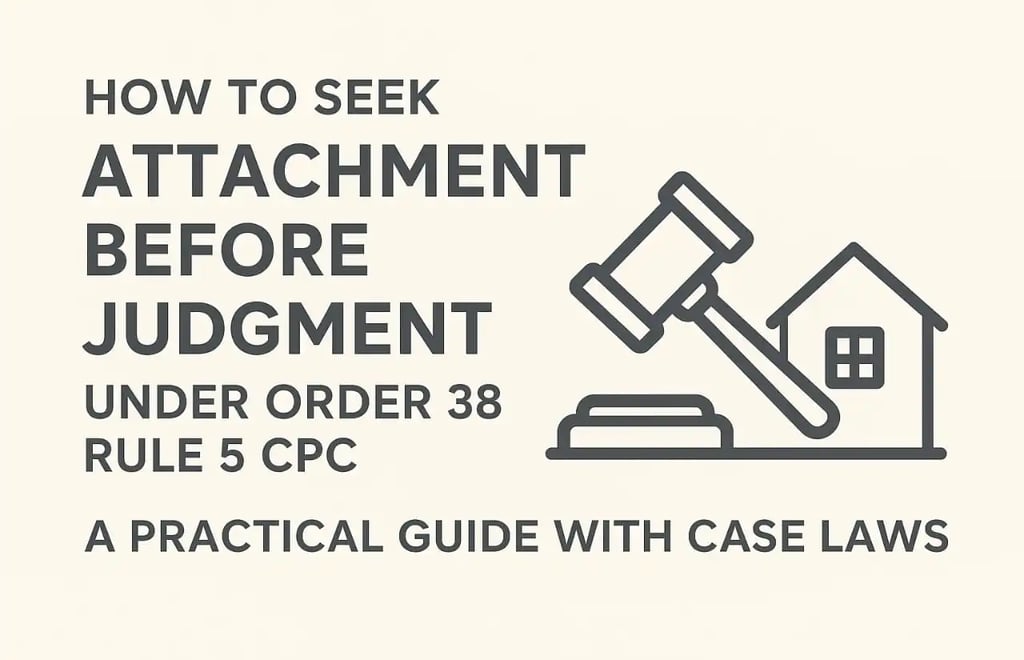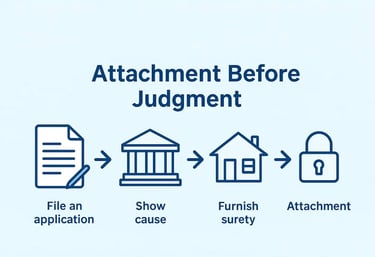Attachment Before Judgment under Order 38 Rule 5 CPC | Practical Guide with Case Laws
Learn how to seek attachment of property before judgment under Order 38 Rule 5 CPC. Step-by-step guide, essential ingredients, and key case laws explained for lawyers and litigants.
Author - THelawcritiQue
9/30/20255 min read


How to seek Attachment of a property Before Judgment under Order 38 Rule 5 CPC : A Practical approach with Case Laws
Introduction
Attachment before judgment available under the Order 38 Rule 5 of the Code of Civil Procedure, 1908 - is sought by a plaintiff in a money suit when there is a reasonable apprehension that the defendants are going to alienate or conceal their property with a view to frustrate the potential decree that may be passed against them. Attachment order if granted will tie the hands of the defendant, restricting from alienating, concealing or otherwise interfering with his property until disposal of the suit. Since this interferes with property rights even before the court decides the case, it is considered an extraordinary remedy to be granted only after strict scrutiny as to the circumstances necessitating it.
Essential Ingredients under Order 38 Rule 5 CPC
For an application for attachment to be successful, the plaintiff must establish:
1. prima facie case - plaintiff has to establish that there is prima facie case in his favour
2. intention of the defendant - to obstruct or delay execution of any potential decree
3. specific acts such as - alienation, transfer, or removal of property in part or whole of the property
4. fraudulent intention - defendant might rightfully use his property rights to alienate or change as a commercial or business transaction or even for family necessity - the intention of the defendant to delay or obstruct the execution of a potential decree has to be necessary
How to lawfully seek for Attachment Before Judgment
Now let us see the step by step guide on how to obtain attachment of a property before judgment
1. File an application with an affidavit under Order 38 Rule 5 CPC
2. Ensure the affidavit contains necessary facts showing the prima facie details of the debt, property details, fraudulent intent of the defendant and a prayer for the necessity of an order.
3. Courts usually issue notice to show cause why an order of attachment need not be issued.
4. Direction to furnish surety - The defendant may avoid attachment by furnishing security sufficient to satisfy the potential decree.
5. If the defendant fails to furnish security, the court orders attachment of specified attachable property subject to exemptions under Section 60 CPC.
Prominent Case Laws for quick Reference relating to Attachment of Property before Judgment
The various instances of attachment before judgment in the authoritative cases in India are as follows:
Transferred assets - where the defendant had transferred 80% of his properties and also changed the name of the firm. It was held that an attachment before judgment should be issued. - Ram Sarup v. Chiranjilal (1941) A.M.L.J. 30, also in Santosh Kumar v. Bhai Mool Singh, AIR 1958 SC 321 it was held that specific averments of fraudulent disposal of property by the defendant can justify attachment
Insolvent condition - when a defendant is in the stage of insolvency is a proper instance to grant attachment before judgment. In a case where it was proved that the defendant company was in insolvent condition and was rapidly disposing of its assets. An order for attachment was made - General Coal Supply Co. Ltd., Amritsar v. Karamchand Thapar & Bros. Ltd., Calcutta, A I. R. (21) 1934 Lah. 594
Moving away from the jurisdiction of the court - where the defendant disposed of his assets at lesser price and moved to Pakistan with an intention to conduct his business there, the Court rightly granted attachment of remaining properties - Premraj Mundra v. Md. Maneck Gazi, AIR 1951 Cal 156
On specific grounds - The Supreme Court in this case elaborated on the principles governing the grant of attachment before judgment, underscoring that such orders should not be issued mechanically but based on specific grounds - Raman Tech. & Process Engg. Co. v. Solanki Traders, (2008) 2 SCC 302
Extraordinary Relief - in case where the court observes a strong prima facie case in favour of the plaintiff and if the Court is satisfied that the defendant is likely to defeat the decree in future as and when it is passed, then the Court shall grant attachment even before final adjudication, hence it is an extraordinary relief given to the plaintiff by the Court - Vareed Jacob v. Sosamma Geevarghese.
Need not enquire into the correctness of averments - the Supreme Court held while disposing an application under Order 38 Rule 5 CPC, it required to form a prima facie opinion at that stage. It need not go into the correctness or otherwise of all the contentions raised by the parties. Rajendran vs Shankar Sundaram - 2008 SUPREME COURT 1170
Sardar Govindrao v. Devi Sahai, AIR 1951 Nag 343 – simple allegations that the defendant’s indebtedness is not a ground for attachment. It is essential that the defendant is acting with intent to obstruct or delay execution.
Property situated outside the jurisdiction of court can also be attached - the courts can exercise jurisdiction of the properties situated out of its jurisdictional limitations by strictly following the procedure emphasized under section 136 of the Civil Procedure Code, 1908
Practical Takeaways
Precautionary relief to secure a potential decree that may be passed
There should be a Prima facie case in favour of the plaintiff and also the defendant is acting with intent to obstruct, delay or frustrate the decree
Courts require specific and cogent material before ordering attachment.
Bald allegations of possible alienation are insufficient.
The remedy is extraordinary, not to be used as a harassment tool and litigation strategy.
Conclusion
Attachment before judgment is a preventive measure that deprives the defendants of his privilege to use his property with absolute rights. Such orders can impose restrictions on his right to property. Therefore, it is necessary to properly assess the application based on the facts and strict proof of intention to alienate. A well-drafted application, supported by an affidavit strengthened by a solid authoritative case law, makes all the difference in practice. Courts need to ensure that it protects decree-holders without unjustly harassing defendants.
Frequently Asked Questions (FAQs)
1. What is attachment before judgment under Order 38 Rule 5 CPC?
Attachment before judgment is a preventive remedy where the court restricts the defendant from transferring or disposing of property to ensure execution of a possible decree in favor of the plaintiff.
2. When can attachment before judgment be granted?
Where the plaintiff shows a prima facie case and strict proof that the defendant is attempting to alienate the property in order to obstruct or delay execution by alienating or concealing property.
3. Is attachment before judgment an extraordinary remedy?
Yes. Courts have consistently held that it is an extraordinary remedy, to be exercised cautiously and only when fraudulent intent or risk of defeating a decree is established.
4. Can property outside the jurisdiction of the court be attached?
Yes. Under Section 136 CPC, courts can order attachment of property situated outside their jurisdiction, provided due procedure is followed.
5. Does the court need to verify the correctness of all allegations before granting attachment?
No. At this stage, the court only needs to be satisfied that a prima facie case exists. It does not conduct a detailed inquiry into the correctness of all averments.
6. Can mere indebtedness of the defendant justify attachment before judgment?
No. Mere indebtedness is insufficient. There must be clear proof that the defendant intends to obstruct or delay execution of a possible decree.
7. Can the defendant avoid attachment?
Yes. The defendant can avoid attachment by furnishing sufficient security or surety as directed by the court.


Connect With Us Through
Connect with us
© 2025. All rights reserved.
